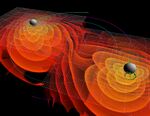Astronomy:GW190814
| Spectral class | Gravitational wave |
|---|---|
| Date | 21:10:39 UTC |
| Instrument | LIGO, Virgo[1][2] |
| Right ascension | 03h 33m |
| Declination | 04h 45m |
| Epoch | J2000.0 |
| Distance | 241 megaparsecs (790 Mly)[1] |
GW 190814 was a gravitational wave (GW) signal observed by the LIGO and Virgo detectors on 14 August 2019 at 21:10:39 UTC,[2] and having a signal-to-noise ratio of 25 in the three-detector network.[1] The signal was associated with the astronomical super event S190814bv, located 790 million light years away, in location area 18.5 deg2[n 1][1][3][4] towards Cetus or Sculptor.[5][6][7][8][9][10] No optical counterpart was discovered despite an extensive search of the probability region.[11]
Discovery
In June 2020, astronomers reported details of a compact binary merging, in the "mass gap" of cosmic collisions, of a first-ever 2.50–2.67 M☉ "mystery object", either an extremely heavy neutron star (that was theorized not to exist) or a too-light black hole, with a 22.2–24.3 M☉ black hole, that was detected as the gravitational wave GW190814.[1][12]
The mass of the lighter component is estimated to be 2.6 times the mass of the Sun (M☉ ≈ 1.9891×1030 kg), placing it in the aforementioned mass gap between neutron stars and black holes.[1][13][14][15][16][17]
Despite an intensive search, no optical counterpart to the gravitational wave was observed. The lack of emitted light could be consistent with either a situation in which a black hole entirely consumed a neutron star or the merger of two black holes.[14]
See also
Notes
- ↑ The relatively large and distant area of the sky within which it is claimed to be possible to localize the source.
References
- ↑ 1.0 1.1 1.2 1.3 1.4 1.5 Abbott, R. (23 June 2020). "GW190814: Gravitational Waves from the Coalescence of a 23 Solar Mass Black Hole with a 2.6 Solar Mass Compact Object". The Astrophysical Journal Letters 896 (2): L44. doi:10.3847/2041-8213/ab960f. Bibcode: 2020ApJ...896L..44A.
- ↑ 2.0 2.1 Staff (2020). "GW190814 Factsheet - Lowest mass ratio to date - Strongest evidence of higher order modes". LIGO. https://dcc.ligo.org/public/0168/G2000846/002/GW190814%20Factsheet.pdf.
- ↑ Greco, G. (2020). "Handling gravitational-wave sky maps for EM-followUP observations - Second ASTERICS Virtual Observatory School". Asterics2020.eu. https://www.asterics2020.eu/dokuwiki/lib/exe/fetch.php?media=open:wp4:school2:gravitationalwaves-tutorial-7.pdf.
- ↑ Berry, Christopher (10 August 2018). "Sky-localization of Gravitational wave observations". CplBerry.com. https://cplberry.com/tag/sky-localization/.
- ↑ Staff (14 June 2019). "GraceDB - Gravitational-Wave Candidate Event Database - Superevent Info". LIGO. https://gracedb.ligo.org/superevents/S190814bv/view/.
- ↑ Staff (23 June 2020). "Black hole or neutron star? - LIGO-Virgo scientists find mystery object in 'mass gap'". Pennsylvania State University. https://news.psu.edu/story/623786/2020/06/23/research/black-hole-or-neutron-star.
- ↑ Starr, Michelle (16 August 2019). "Early Reports Indicate We May Have Detected a Black Hole And Neutron Star Collision". ScienceAlert.com. https://www.sciencealert.com/we-might-have-just-caught-a-black-hole-in-the-act-of-eating-a-neutron-star.
- ↑ Mandelbum, Ryan F. (26 August 2019). "Mystery Deepens Around Newly Detected Ripples in Space-Time". Gizmodo. https://gizmodo.com/mystery-deepens-around-newly-detected-ripples-in-space-1837581646.
- ↑ Starr, Michelle (11 February 2020). "First Papers on The Black Hole-Neutron Star Merger Are In. Here's What We Didn't See". ScienceAlert.com. https://www.sciencealert.com/the-first-papers-are-in-following-up-the-black-hole-neutron-star-merger-here-s-what-they-found.
- ↑ Ackley, K.; et al. (5 February 2020). "Observational constraints on the optical and near-infrared emission from the neutron star-black hole binary merger S190814bv". arXiv:2002.01950v1 [astro-ph.SR].
- ↑ Staff (25 June 2020). "GW190814 Sheds Light on Mass Gap between Neutron Stars and Black Holes". Sci-News.com. http://www.sci-news.com/astronomy/gw190814-mass-gap-neutron-stars-black-holes-08574.html.
- ↑ Staff (23 June 2020). "GW190814". LIGO Scientific Collaboration. https://www.ligo.org/detections/GW190814.php.
- ↑ Staff (24 June 2020). "Black hole or neutron star? - LIGO-Virgo scientists find mystery object in 'mass gap'". Pennsylvania State University. https://news.psu.edu/story/623786/2020/06/23/research/black-hole-or-neutron-star.
- ↑ 14.0 14.1 University of Birmingham (23 June 2020). "Gravitational wave scientists grapple with the cosmic mystery of GW190814". EurekAlert!. https://www.eurekalert.org/pub_releases/2020-06/uob-gws062320.php.
- ↑ Overbye, Dennis (24 June 2020). "A Black Hole's Lunch Provides a Treat for Astronomers - Scientists have discovered the heaviest known neutron star, or maybe the lightest known black hole: "Either way it breaks a record."". The New York Times. https://www.nytimes.com/2020/06/24/science/black-hole-ligo-gravitational.html.
- ↑ Starr, Michelle (24 June 2020). "Astronomers Detect First-Ever Mystery Object in The 'Mass Gap' of Cosmic Collisions". ScienceAlert.com. https://www.sciencealert.com/gravitational-waves-may-have-just-given-us-a-black-hole-smaller-than-we-thought-possible.
- ↑ Cho, Adrian (24 June 2020). "Gravitational waves reveal lightest black hole ever observed". Science. https://www.science.org/content/article/gravitational-waves-reveal-lightest-black-hole-ever-observed.
External links
- "Detections". LIGO. http://ligo.org/detections.php.
- Video (2:25): GW190814 binary black hole merger – overview on YouTube (24 June 2020; Science Fellow)
- Video (1:32): GW190814 binary black hole merger (animation) on Vimeo (24 June 2020; LIGO Scientific Collaboration)
- Video (1:32): GW190814 binary black hole merger (animation) on YouTube (23 June 2020; Max Planck Institute for Gravitational Physics)
- Video (0:10): GW190814 gravitational wave from mysterious object on YouTube (23 June 2020; Gravitational-wave Open Science Center (GWOSC))
 |




